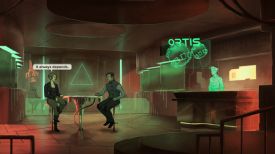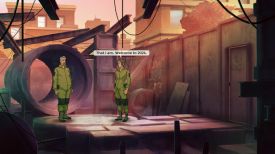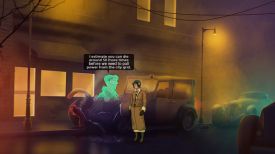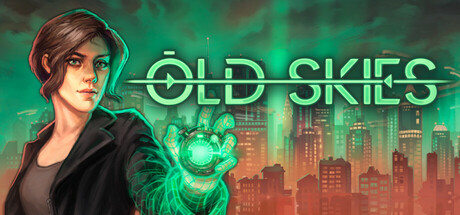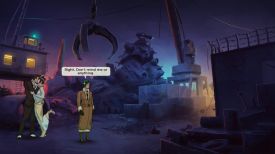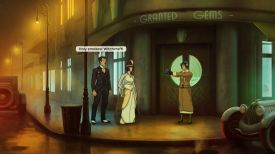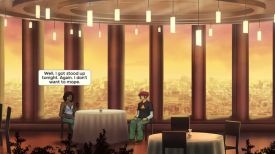|
By flotsam
Old
Skies
Wadjet Eye Games
As the Steam page says, time
travel is real and history is up for grabs.
You play Fia Quinn, whom we have
met before but not yet (relatively speaking). Which is a round about way
of saying that timey-wimey time travel stuff is a whole heap of fun.
Like I said, you play Fia Quinn,
a time agent for ChronoZen, the organisation charged with making sure
the time stream stays relatively ordered. Or at least as ordered it as
it can be when people can pay to hop back in time to e.g., have a last
supper at a favourite burger joint. Which is how we meet Fia, escorting
a client to 2024 for that very purpose. But when the client goes rogue,
time threatens to do what time does when stuff that like that happens,
which means Fia has to sort it out.
Other clients are more upfront
with their ambitions, usually involving changing something rather than
to make things different now. Which apparently is ok, generally. The
game does an excellent job of explaining and applying the Ďrulesí of
time travel to your endeavours. Fia herself is chronolocked, which means
changes in time ripple around her, but Fia remains as is. Navigating
those ripples is part of the story, as is the fact that certain people
are off limits when it comes to making changes. You can discover all the
details for yourself (and I liked that they unfolded across the game
rather than coming in a single dump of exposition), but suffice to say
that time is a relative construct, except when it isnít.
The visual aesthetic is particularly appealing. It has an art nouveau
feel, especially when it comes to the characters, and they regularly
reminded me of those advertising posters by people like Cappiello. No
more so than when Fia initiates a garment change in order to fit into
the current time stream.
Game-play is very much
point-and-click, and you can save at will. The inventory ribbon appears
top of screen in response to the mouse, where you have access to your
items as well as a digital archive with search terms that increase as
you uncover information. Examining items can be important as the time
ripples Ė documents in particular might change Ė and searching in the
archive when you get a new lead (you will know when) can pay dividends.
You also have access to a field
manual full of all sorts of interesting field agent information, and a
'phone' to contact Nozzo back in your original timeline. He monitors and
assists your activities in the past, and can provide insights or
suggestions should you be stuck.
He also has the very important
task of activating your Paradox Field Excluder, which means rewinding
time when Fia dies. Which she will.
Quite a bit.
Much of it is inevitable. The
narrative will make it happen. How much more death will occur will
depend on how many tries it takes you to stop it from happening.
I did get sick of these death
loops. There was one that had an answer discernible within the game
(perhaps there are more and I missed the solution) but by and large its
trial and error - die, try something else, die, try something different,
die etc. Sometimes there is more than one person to save, requiring a
more convoluted solution (I enjoyed these more as they added an
additional dimension) but before the end of the game I confess I was
using a walkthrough to get me through these sequences.
Other puzzling involves finding
and using items, applying information you have uncovered to piece
together a code or password, and triggering the way forward by asking
the right person the right question. Whilst I was clueless at times, I
had fun with them all, preferring the middle sort and putting the latter
at the bottom. In that regard, you will need to chat incessantly,
particular responses being essential to triggering a way forward.
The game is well voiced, and the
sound palette is appropriately good. Game screens are generally what you
see in front of you (i.e., they donít slide or scroll) and you can
highlight hotspots to aid your searching. Exit points will take you to a
scrolling streetscape, where available locations are represented by
icons top of screen. Just click one and that's where you will be.
But donít be too hasty. The chat
that might take place as you stroll along can be illuminating, if only
in terms of background or detail.
The roll-over aspect to looking
at things warrants mentioning. Instead of clicking to look at something,
moving the cursor there will generate a little pop-up description of
whatever it is you are looking at. I liked it a lot. Other icons will
indicate you might be able to do something different at a hotspot.
The game plays in Chapters, each
based on a different client, but it is way more convoluted than that.
Such is the nature of the timestream. The Chapters are also different in
nature, so you donít feel you are just doing the same thing with someone
else. My favourite was the one where you had to stop multiple versions
of Fia encountering themselves, and I also enjoyed those where you had
to jump back and forth in time to learn things in the past/future that
you used in the future/past.
And I particularly enjoyed how
it played out.
Despite my feelings on the death
loops, I had a very good time being Fia. Itís an elaborate piece of
storytelling, and while my playthrough was impacted by my use of a
walkthrough, I reckon there is 10-15 hours of game play awaiting you,
and possibly more.
I look forward to their next
game.
I played on:
OS:
Windows 11, 64 Bit
Processor: Intel i7-9700K 3.7GHz
RAM:
Corsair Dominator Platinum RGB DDR4 32GB
Video
card: AMD Radeon RX 580 8192MB
GameBoomers Review Guidelines
June 2025
design copyright© 2025
GameBoomers
Group
 GB
Reviews Index GB
Reviews Index |
